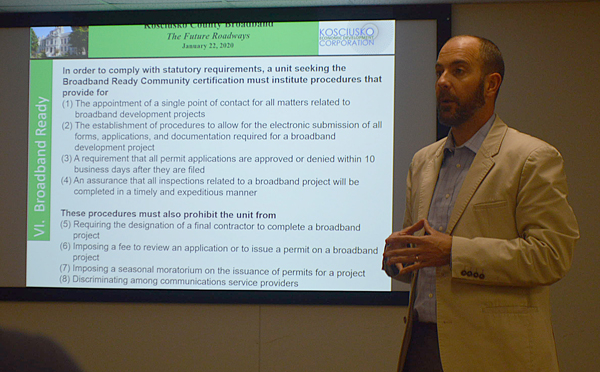
County, city, town, township and school officials gathered Wednesday evening to hear about and discuss the current status and the future of broadband internet in Kosciusko County.
By the end of the conversation, the idea to form a consortium to pursue getting the county to be Broadband Ready Certified appeared to be the next step in the process.
The 1-1/2-hour meeting was held in the basement meeting room of the Justice Building and led by Kosciusko Economic Development Corp. CEO Alan Tio and President of Pyramid Consulting Services Terry Burnworth.
Burnworth discussed how social media was becoming extremely important in today’s world and is an internet-based product that requires broadband. From a public safety point of view, he said a bill down at the statehouse, if passed, would make a dispatcher a “first responder,” and dispatchers rely heavily on real-time texting, real-time video systems, etc.
There’s more urban sprawl than rural because of “connectivity,” he said. In rural communities, he said “you’ve got to have connectivity. And you’ve got to be connected and in a competitive way.”
Connectivity will become “extremely important,” he said, “in any retention of the population you currently have and in bringing in any population. You have a beautiful county here … and retention is going to be extremely important.”
Tio added that, “We need to grow the population, of our county, of our region, of our state.” During former Governor Mike Pence’s administration, Tio said the biggest challenge then (five to seven years ago) was population growth. “We don’t have the people to fill the jobs, to sustain our communities. And with these demographic changes, if we continue at our current population growth rate … we’re going to see the workforce population shrink.”
Since that’s not wanted because it would affect the companies, services and the county’s prosperity, he said “we do need to grow the population.” The Fort Wayne Region wants to grow its population by 1 million by 2031, with Kosciusko County being a part of that region and needing to grow by 21,000 people by that timeframe.
“So we’ve got some work to do. Right now, we’re treading waters for population growth,” Tio said. “So this is no longer a ‘nice to have, maybe we should have some internet here and there.’ It’s a must have.”
With the internet being important to the generations younger than the Baby Boomers, it’s important to the county to have broadband to draw populations in.
Tio said KEDCo has heard about the federal government awarding money to providers to serve “under-served” areas.
He said they’ve reached out to some of the broadband providers and asked what they have currently and what could they have. Tio said they weren’t just looking for one provider to serve the entire county because there’s different geography, population density, etc.
“Throughout different parts of the county, let’s find the right providers that make sense for that market, that part of the county, and let’s do some matchmaking,” Tio said.
When Burnworth was hired by the county commissioners to look at the emergency services’ communications, KEDCo asked if they could align their efforts to have discussions with internet providers about serving the entire county.
Burnworth explained the two types of wireless broadband – fixed and mobile; the types of deployment – private/proprietary, public-private, municipal and co-operatives; and the six types of broadband technologies: DSL, cable, fiber optic, fixed wireless, satellite and powerlines.
Looking at a chart Burnworth found, Tio said “66% of small rural businesses say poor internet or cellphone connectivity negatively impacts their business.” Tio said it’s known that many small businesses in Kosciusko County would agree with that. And 38% of rural small businesses say they can’t hire the right talent with the right digital skills in their area because of the lack of good broadband connectivity. Forty-one percent of rural small businesses agree that policymakers should create incentive programs to make it easier for rural small businesses to incorporate digital technology into their daily operations. That’s just for Indiana.
Burnworth said Indiana is a rural community, so Kosciusko County needs to look at how it’s going to have that connectivity.
The Digital Divide Index ranges in value from 0 to 100, where 100 indicates the highest digital divide. The score is made up of variables related to broadband infrastructure and adoption and was established by a Purdue professor. Kosciusko County is “pretty much around the middle of the state” at 43.64, Burnworth said. The goal is to get to zero. The only county in Indiana at zero is Hamilton County, with Crawford County at 100.
“The reason I wanted to show this is, because, I would think from your point of view it’s nice to be in the middle of the state, but you want to be better than the others. You’re competing against these other counties,” Burnworth said. “You’re competing against these people for people to move here, for people to stay here.”
Tio talked about the Broadband Ready Certification process and the requirements for the certification. He said he’d also like to form a coalition to work on the certification. Some of the nearby communities that already have the certification include Noble, Whitley and Marshall counties and the towns of Larwill and South Whitley.
After Tio and Burnworth’s presentation, the meeting was opened up for questions.
County Commissioner Cary Groninger said the whole idea of Wednesday’s meeting was “we need input from you. We want your ideas. More heads in the room. We want to see different viewpoints that maybe we’re missing that we don’t know are out there or issues you’re dealing with.”
He said maybe there’s people in the community that “might be gifted in some of these areas” that might sit on a board as the county moves forward on the broadband issue.
Warsaw Community Schools Chief Technology Officer Brad Hagg said, “I’m all in. … I’ll do whatever you guys need me to do to support this. This is actually one of my goals at the school district this year, is to increase broadband in our community for our rural folks. So I’m 100% in. Whatever you need me to do, however I can help.”
Burnworth asked Hagg if WCS participated in eLearning. Hagg said yes, but it’s not the preferred style of learning and they won’t do more than three days of eLearning in a row.
Tippecanoe Valley Schools Superintendent Blaine Conley said Valley doesn’t do eLearning because “at least 20% of my kids” aren’t going to have the necessary connectivity at home to do their school work. “This is one of the issues we’re dealing with.” He echoed Hagg’s statement that Valley was all in to get better broadband in the county.
Tio concluded the 90-minute meeting by saying, “We’ll put out a suggestion on how we can build a consortium, but we’ll need input from others along the way to get this going here to start the year.”




